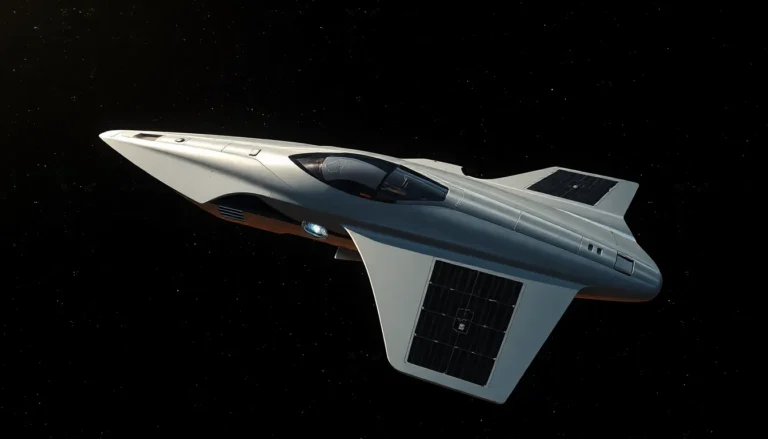Table of Contents
ToggleIn the vast expanse of space, where gravity takes a coffee break, astronauts rely on their trusty extravehicular mobility units (EMUs) to float around like cosmic superheroes. These high-tech suits are more than just fashionable space attire; they’re life-saving marvels designed to keep astronauts safe while they tackle the universe’s most daunting tasks.
Overview of Extravehicular Mobility Unit
Extravehicular mobility units (EMUs) become vital tools for astronauts during space missions. These sophisticated suits protect against harsh environments and allow for essential tasks outside spacecraft.
Definition and Purpose
An EMU functions as a life-supporting garment for astronauts. It maintains pressure and temperature while supplying oxygen for breathing. More than protection, the suit manages carbon dioxide and shields against radiation and micrometeoroids. Astronauts utilize EMUs for repairs, scientific experiments, and routine maintenance in space. These suits enable mobility and flexibility, ensuring astronauts can accomplish critical objectives effectively.
Historical Development
The journey of EMUs began in the 1960s, influenced by early space suits like the Mercury and Gemini models. NASA designed the first true extravehicular mobility unit for the Apollo missions in the late 1960s. Subsequent advancements occurred during the Space Shuttle program, enhancing comfort, mobility, and functionality. Modern EMUs incorporate innovations like improved thermal insulation and advanced communication systems. Technological progress continues, with ongoing research aimed at creating next-generation suits for future missions to the Moon and Mars.
Design and Functionality
Extravehicular mobility units (EMUs) feature sophisticated designs tailored for space conditions. Emphasis on vital components enhances their effectiveness in protecting astronauts.
Key Components
Pressure garments maintain a stable environment by preventing the suit from ballooning in the vacuum of space. Life support systems supply oxygen and control carbon dioxide levels, ensuring astronaut safety during extravehicular activities. Thermal insulation regulates temperature, protecting against extreme highs and lows. Communication gear allows for clear dialogue between astronauts and mission control, facilitating important operations. Mobility joints, such as wrists and elbows, enable astronauts to perform tasks with precision.
Suit Technology
Modern EMUs incorporate advanced materials, which enhance durability while reducing weight. Smart sensors monitor suit conditions, providing real-time data about pressure and temperature changes. Augmented reality displays assist astronauts with navigation and operational guidance, improving task efficiency. Compact power sources fuel essential systems, ensuring long-lasting performance in challenging environments. Innovative fabric technologies promote flexibility and ease of movement, making tasks easier in microgravity.
Applications of Extravehicular Mobility Unit
Extravehicular Mobility Units (EMUs) serve critical functions in a variety of applications related to space exploration and research. These specialized suits enhance astronauts’ capabilities beyond the confines of their spacecraft.
Space Exploration Missions
EMUs play a pivotal role in space exploration missions. Astronauts use these suits during activities like spacewalks and lunar landings. They conduct repairs and install equipment outside the International Space Station. Some missions require astronauts to perform surface explorations on other celestial bodies. The design of EMUs allows for mobility and protection in harsh environments. Technical enhancements facilitate more comprehensive functions, which aid in executing mission objectives effectively. Each suit is equipped to withstand extreme temperatures, micrometeoroids, and radiation, ensuring astronaut safety during every operation.
Scientific Research
Scientific research benefits significantly from the application of EMUs. Astronauts utilize these suits to collect samples and conduct experiments in space. Some experiments rely on microgravity conditions, requiring astronauts to perform intricate tasks outside their spacecraft. EMUs support various scientific objectives by holding essential life support systems and equipment. Researchers depend on the advanced sensors integrated into the suits, which monitor environmental conditions and vital signs. Analysis of data collected during spacewalks contributes to a better understanding of phenomena, such as material reactions in space and the effects of radiation on biological samples. Each task performed in an EMU brings scientists closer to unlocking the mysteries of the universe.
Challenges and Innovations
Challenges exist in the design and functionality of extravehicular mobility units (EMUs). Current limitations include bulkiness that restricts astronaut movement, impacting the ability to perform intricate tasks. Weight also poses a challenge, as heavier suits increase launch costs and exertion levels in microgravity. Temperature regulation becomes complicated in extreme environments, creating risks for astronauts during spacewalks. Additionally, the longevity of suit materials under space conditions raises concerns, as wear and tear can compromise safety.
Future advancements promise to address these challenges. Researchers focus on creating lighter materials that maintain durability while enhancing flexibility. Innovations in life support systems aim to improve oxygen supply and carbon dioxide removal more efficiently. Miniaturization of technology could streamline communication and monitoring systems, ensuring seamless astronaut interaction with mission control. Developing adaptive suits with features for temperature control will enhance comfort during long-duration missions. Finally, integrating artificial intelligence into EMUs could optimize performance, tailoring support based on individual astronaut needs.
Conclusion
Extravehicular mobility units are indispensable for the future of space exploration. Their evolution reflects humanity’s relentless pursuit of knowledge beyond Earth. As technology advances, EMUs will become even more efficient and capable, enhancing astronauts’ ability to conduct vital research and perform complex tasks in the harshest environments.
The ongoing innovations promise not only to improve safety and comfort but also to expand the horizons of what astronauts can achieve during missions to the Moon, Mars, and beyond. As we look ahead, the development of next-generation EMUs will play a crucial role in unlocking the secrets of the universe and ensuring the success of future explorations.







